



Minimizing Floor and Slat Egg Problems
By Pete Sbanotto, breeder specialist for the Cobb World Technical Support team. One of the most perplexing problems facing egg producers is getting the hens to use the nests provided rather than laying eggs in other locations.Introduction
Many times a producer will do an excellent job of providing
 Pete Sbanotto Pete Sbanotto |
Why is this important? Producers and hatcheries want hatching eggs that are clean, free from bacteria, and untouched by moisture. In most cases, eggs laid in the nests have the best chance of getting to the hatchery clean and free of excess contamination. For the producer, less labor is required to pick up floor eggs and more clean hatching eggs are produced.For the hatchery, nested eggs have less surface contamination, producing a higher hatch and healthier chicks. For the broiler producer, the result is healthier and stronger chicks delivered to his farm. For the production company, nested eggs mean increased return due to a higher yield of good chicks.
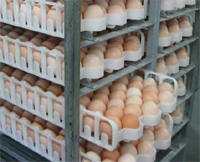 Clean Hatching Eggs Clean Hatching Eggs |
For this article, the term “floor eggs”will be used to define any egg which has been laid outside the nests. These are also called “ground eggs”, “commercial eggs”, or “slat eggs”.
Possible Causes and Solutions
There are several items that need to be considered in reducing the number of floor eggs, including rearing, male/female effects, lighting, ventilation, and equipment.
Rearing House
Consideration needs to be given to lighting and equipment design and placement in the rearing house. Light intensity in rearing may affect the birds’ response to light in the production house. Generally, after the starting phase for pullets, (three to four weeks of age), light intensity should be reduced for the remainder of the pullet phase to allow for at least a threefold increase in intensity when moving to the production phase. The lighting needs to be uniform within the house.
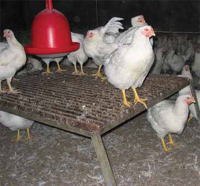 Training slats in pullet house. Training slats in pullet house. |
It is also important to ensure that birds do not damage equipment or injure themselves by selecting inappropriate nesting sites. However, mechanisms must be implemented that do not discourage the young hen from jumping onto the slats. Providing randomly placed slats or perch poles throughout the rearing house beginning at eight to ten weeks of age will encourage the birds to exhibit natural perching behaviors and reduce the likelihood of reluctance to jump onto the slats. It is best if these training perches are of the same design and made of the same material that the birds will see in the production house.
Production House
Male/Female Effects
Differences in the weight and maturity level of males and females can affect nesting behavior. If the males are too heavy or are far ahead of the females in maturity, “slatting” of the hens may result. If males pursue the females too aggressively for mating, the females become cowered and reluctant to expose themselves to the males. This may interfere with the female selecting a proper nesting site. It is recognized that most hens will choose a site to lay her egg, and then return to that same site every time she is ready to lay. According to research done by Drs. Jeanna Wilson and John Worley at the University of Georgia: “A small irritation during the time when a hen is forming the habit of where to lay her eggs may cause her to lay in an undesired location, and she will continue to lay there throughout her life, even though the irritation is removed.”
Lighting
Eliminating shadows is a big challenge in properly lighting the house. Generally, artificial lighting should be placed in two or three rows in order to distribute the light as evenly as possible across the house and into the corners. This is especially important in totally enclosed or darkout production houses. It is also important to have the proper amount of intensity.
A minimum of 6 to 8 foot-candles (64 to 86 lux) at bird level in the darkest area in the house is necessary. Some solid sidewall production houses with inadequate light intensity have experienced up to a 30% floor egg rate. In houses with manual gather nests, it is important to have bulb spacing where the shadows under the nests are eliminated as much as possible, thus avoiding the darkened areas which may be an enticing place for hens to lay.
Ventilation
 Figure 1. With low negative pressure (2) the hens may find the nests very cold in the wintertime as a draft could be directed to them. With very low negative pressure (3), nests will tend to be very hot in summer. Figure 1. With low negative pressure (2) the hens may find the nests very cold in the wintertime as a draft could be directed to them. With very low negative pressure (3), nests will tend to be very hot in summer. |
Airflow patterns are another important factor. For example, uneven ventilation may cause birds to migrate to more comfortable areas of the house, thus creating an “artificial” shortage of nest space.During hot weather, the ventilation equipment may be doing a great job of tunneling the air lengthwise through the house, but there may be little or no air flow inside the nest, making it very uncomfortable for the hens to remain on the nests long enough to complete laying. With winter cross-flow ventilation, it is possible that the sidewall inlets could be directing the cold incoming air into the nests facing the inlet wall, making it too cool for the hens on the nest (Figure 1).
Equipment
Feeding
Timing of feeding and type of feeding equipment are other important considerations for minimizing floor eggs.The type of feeder may affect the birds’ behavior. Sometimes birds will lay eggs under the pans in a pan-type of feeder setup when the feeder height is not set correctly, or when there are other factors causing the birds to look for an alternative site. When trough (track and chain) feeders are set at an improper height or too close to the nest openings, they can become a barrier to the hens’ easy movement to the nests, contributing to an increase of floor eggs. The time of feeding can also interfere with laying. Generally, the feed needs to be available either as soon as the lights come on or at some time after most of the eggs are laid for the day. Feeding two or three hours after the lights come on tends to lure some hens away from the nest to eat just when they are ready to lay, increasing the number of floor eggs.
Additionally, the type of grille and the amount of male activity around the female feeding area may upset the hens and lead to more floor eggs. It is important to train the males to eat from the male feeders as soon as possible in order to help keep the hens as calm as possible, as well as to know the actual amount of feed that the females are consuming. When using a separate male feeder, raising the male feeder during the day will discourage hens from nesting underneath.
Water
Drinker space, type, and flow rate are also important. If not adjusted properly, bell type drinkers can encourage hens to lay under them. Nipple drinkers that are set too low may cause a physical barrier to the bird movement to the nests. An inadequate number of nipples or a low flow rate can cause the hens to stay next to the drinker line a long time in order to get enough water, keeping them off the nest.
Nests
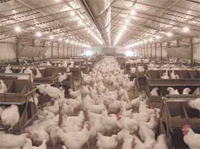 Two-tiered nests with proper perch poles to allow easy access to top tier. Two-tiered nests with proper perch poles to allow easy access to top tier. |
There are any number of designs and brands of nests available and all have worked well at some time.However, all nests need constant management in order to make them as comfortable as possible for the hens. In single-hole nests, the nest opening must be wide and high enough to accommodate the hen entering, turning around, and exiting the nest comfortably. There must be adequate ventilation inside the nest to keep the hen comfortable in hot weather. The nests should be located where the hens do not have to range more than necessary to find the proper place to lay.
Perhaps the most debated item in nest design is how many hens per nest opening the nest system will accommodate.Most primary breeders recommend one hole for every four hens in order to have adequate nest space and avoid floor eggs. Some nest designs (especially mechanical nests), allow from 5.5 to 6.25 hens per opening. Exceeding these recommendations will greatly increase the likelihood of floor egg problems.
Nest maintenance is also very important. The cleanliness of the nest pads is always a consideration, but the cleanliness of the egg belt is often overlooked. When the gathering belt is soiled with broken eggs or other foreign material, the odor may make hens reluctant to go into the nest to lay. Some producers will completely change their fabric belts between every flock in order to eliminate the odor and make the nests more inviting to the hens. At the very least, belts should be thoroughly washed and sanitized between flocks.
Another concern is the flaps that separate the nest from the belt. As they age, these flaps tend to curl up, exposing the movement of the belt to the hens. The hens may be frightened by this movement and move off the nests. These flaps should be replaced as soon as they begin to curl.
With slatted houses, it is important to have adequate space for hen movement just outside the nest opening. Placing nests too close to the slat front or too close to the feeder track will make it harder for hens to access the nests and find the proper place to lay.
With manual gather nests in a non-slatted house, the nests can be placed near floor level at the beginning of the flock in order to encourage the hens to use them, and raised later.With twotiered nests, it is important that the hens can access the top tier by using perch poles in front of the nest entrance which provide generous space for the hen to perch and walk as she is looking for a nesting site. The bottom tier should be set outward from the top tier so the hen does not need to jump or fly straight up when trying to access the top nests.
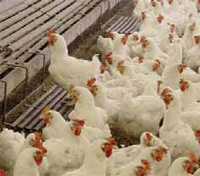 |
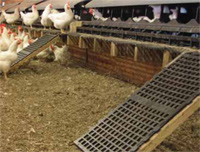 Ramps or steps for houses with higher slats Ramps or steps for houses with higher slats |
Slats
In a slatted house, the slat design is important. A common mistake, especially for yield-type breeds, is a slat system that is too high. If possible, slats should be not more than 18 inches (47 cm) above the floor at the edge of the slats. Remember that litter in the scratch area tends to “disappear” as the flock ages. This is also the time when the hens get heavier and less agile, so the initial slat height m e a s u r e m e n t should be from the floor and not from the top of the litter.
Slats that are higher than 18 inches (47 cm) should be fitted with some sort of step-up mechanism to aid the hens in accessing the nests.
The angle of sloped slats
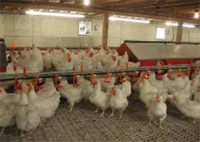 Proper slat slope for a community nest group. Proper slat slope for a community nest group. |
Training the Hens
The most important time a producer can spend in the hen house is in training the hens to use the nests.Normally, this is the time from around 23 weeks of age through peak production. It is best to walk the hens in a slow, consistent manner, in a pattern which encourages the hens to move toward the nests. It is also necessary to block off attractive nesting areas such as corners or under feed bins. In mechanical nests at the onset of lay, the belts should be initially operated at slow speed late in the afternoon in order to keep from frightening the hens off the nests due to equipment noise or vibration. Belt run times can be increased slowly and regularly in order to acclimate the hens to the sound and vibration of the moving belts in a gradual manner during the time that the hens are exploring nests.
Other
Every farm should be checked for electrical current (stray voltage) “bleeding” into the equipment, especially with metal mechanical nests. The electricity supplier can assist in testing the equipment for stray voltage. It takes a very small amount of electrical current, sometimes even as low as one-quarter of a volt, to keep the hens from using the nests properly. Research done by Drs.Wilson and Worley at the University of Georgia has shown that the amount of stray voltage affecting the equipment changes from time to time during the day (for example, increasing in the afternoon hours), so measurements should be made at several times during the day to accurately determine if such a problem exists.
Bird health should not be overlooked, as sick birds are less active and less able to move between the scratch area and the slats to find a nesting site. This can eventually cause more floor eggs. The company breeder technician or veterinarian can assist in minimizing these types of problems.
Summary
While there are no easy answers to reducing the amount of floor and slat eggs, good hen house management tends to minimize the number. In this light,Cobb-Vantress is surveying the industry worldwide in order to collect data and identify items and trends that will help eliminate causes of floor eggs. Perhaps, some day, producers will have a better idea of exactly what to do in order to solve this perplexing problem.
April 2007









